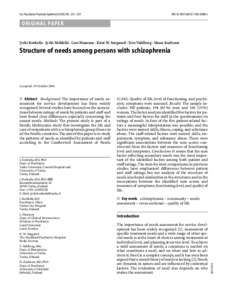Structure of needs among persons with schizophrenia
Knut W Sørgaard; Lars Hansson; Hasse Karlsson; Jyrki Korkeila; Tero Vahlberg; Jyrki Heikkilä
https://urn.fi/URN:NBN:fi-fe2021102752687
Tiivistelmä
Background: The importance of needs assessment for service development has been widely recognised. Several studies have focused on the associations between ratings of needs by patients and staff and have found clear differences, especially concerning the unmet needs.
Methods: The present study is part of a Nordic Multicentre study that investigates the life and care of outpatients with a schizophrenia group illness in all the Nordic countries. The aim of this paper is to study the patterns of needs as identified by patients and staff according to the Camberwell Assessment of Needs (CAN). Quality of life, level of functioning, and psychiatric symptoms were assessed.
Results: The sample includes 300 patients, 194 (65%) men and 106 (35%) women. The factor analysis identified five factors for patients and four factors for staff in the questionnaire on ratings of needs. In four of the five patient-related factors a meaningful interpretation was possible, and the factors were named skills, illness, coping, and substance abuse. The staff-related factors were named skills, impairment, symptom, and substance abuse. There were significant associations between the sum scores constructed from the factors and measures of functioning level and symptoms.
Conclusions: It seems that the sum factor reflecting secondary needs was the most important of the identified factors among both patient and staff ratings. The item-by-item comparisons in previous studies have emphasised differences between patient and staff ratings, but our analysis of the structure of needs also found similarities in the structures and in the associations between the identified sum scores and measures of symptoms, functioning level, and quality of life.
Kokoelmat
- Rinnakkaistallenteet [19207]
